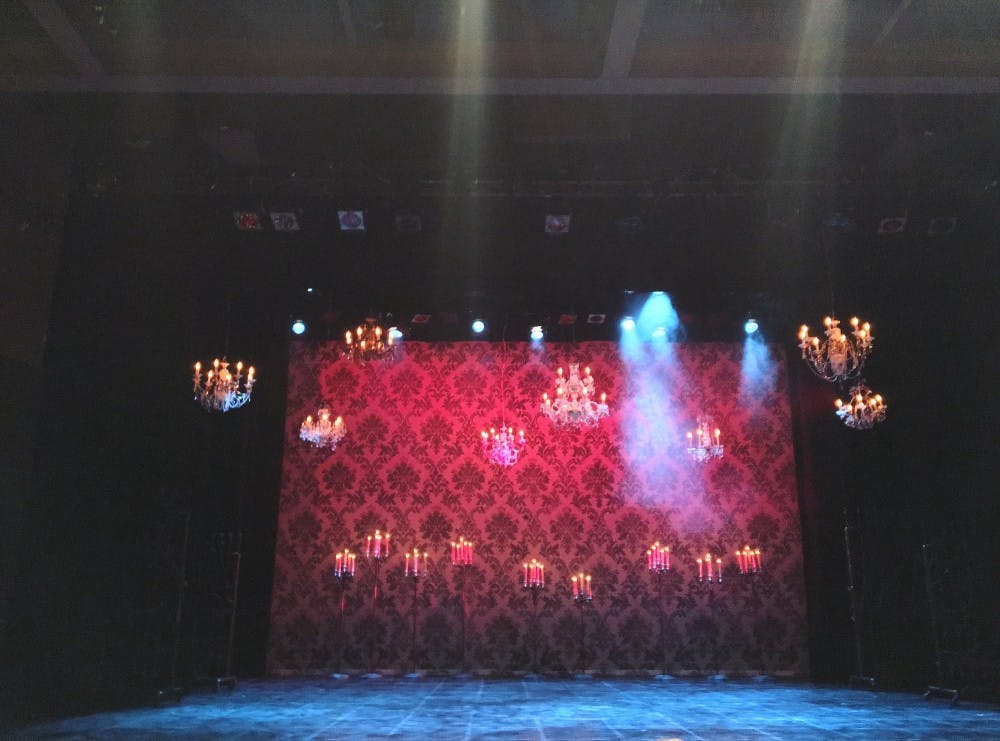AU’s Department of Performing Arts kicked off its spring theater season with an intense, action-packed production of “Dracula” this weekend. With elaborate lighting, chilling sound effects and creepy puppets, the play kept audience members on the edge of their seats throughout the night.
A genderbent cast allowed for thought-provoking commentary on gender roles and power structures. Sophomores Anna Shafer and Mallorie Stern and senior Erica Pierce took on the play’s typically masculine roles of Abram Van Helsing, Dracula and Dr. Thomas Seward, while freshman Zach Ruchkin and junior Tristan Salvon-Harman portrayed Lucy Westphal and Margaret Sullivan, respectively.
With lights flashing and recordings of wolf howls echoing through the theater, “Dracula” immediately threw its audience into the action. A thrilling chase scene ends with Mina Grant, played by sophomore David Brewster, getting brutally attacked by a ferocious hound. In one of the play’s many stagecraft tricks, the hound was portrayed by a life-size puppet maneuvered by ensemble actors.
Shortly after, Abram Van Helsing (Shafer), a Dutch scientist, arrives at an insane asylum after receiving a request for help from Dr. Thomas Seward (Pierce). Seward, left bereaved and confused following the sudden illness and death of his fiancée Mina Grant, turns to Van Helsing for medical assistance after Mina’s friend, Lucy Westphal, begins exhibiting the same symptoms as Grant. The mystery furthers with the disappearance of Lucy’s fiancé Jonathan Harker (Emily Krusche-Bruck) and the arrival of a strange new neighbor known as Count Dracula (Stern).
As Lucy’s symptoms worsen and Jonathan Harker makes a sudden reappearance, Seward and Van Helsing struggle to untangle the complicated web of lies and secrets that surrounds them. And when an asylum patient shows signs of demonic possession, and village children are found dead with bite marks on their necks, it becomes clear that the doctors’ troubles might not arise from something of the natural world.
Amid the horror, gore and violence of the play, senior Callie Trawick provided much-needed comic relief as the morally ambiguous asylum patient Robert Renfield. Trawick delivered witty one-liners and sharp comebacks with ease, eliciting genuine laughs from the audience throughout the night. Yet Trawick also managed to portray Renfield’s many bouts of mania, as well as his vacillations between loyalty to Dracula and to Dr. Seward.
Krusche-Bruck gave an especially compelling performance as Jonathan Harker. In a scene where Harker is forced to recount the reason for his mysterious disappearance, Krusche-Bruck skillfully conveyed his fear and lingering trauma from the experience, adding empathy and emotional depth to the role.
Shafer and Pierce also stood out with their portrayals of stoic and strong-minded male characters, while Ruchkin perfectly played the role of the stereotypically weak and feminine Lucy.
In the original story by Bram Stoker, women are forced to sit aside while the men take charge in the fight against evil. In director Carl Menninger’s production, these normative gender roles were called into question. The language and pronouns of the original script were left unchanged, meaning that in several scenes Ruchkin and Salvon-Harman were referred to as “pretty girls” and “young ladies,” and faced flirtatious advances from male characters.
In a typical production, these casual instances of sexism might go unnoticed -- but with the roles reversed, they were blatantly emphasized. While the audience laughed at some of these parts -- such as when Van Helsing tells Salvon-Harman, as Margaret Sullivan, that “Irish women are beautiful when they’re sad” -- the reversal provoked reflection on the socialization of gender and the patriarchal power structures that persist to this day.
With strong performances and subversive themes, “Dracula” provided a twisted take on a classic tale of the battle between good and evil, and set the stage for what’s sure to be a memorable theater season.





